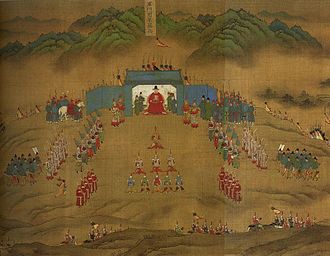Campaigns

The term "Three Great Campaigns of the Wanli Emperor [Era]" was first used by late Ming scholars Feng Menglong (1574–1646) and Gu Yingtai (谷應泰; 1620–1690). It refers to the three most significant wars fought by the Ming dynasty during the reign of the Wanli Emperor (ruled 1572–1620), namely the uprising of indigenous tribes in the southwest, the rebellion of Chinese and Mongolian troops in the northwest, and the Imjin War in the east.[1]
The Three Great Campaigns were:
- Ningxia rebellion (March–October 1592)—A revolt led by Chinese and Mongol garrison soldiers in the city of Ningxia. The insurgents had a force of 20–30,000 soldiers, while the city itself had a population of 300,000. In response, the Ming government mobilized 40,000 soldiers and hundreds of cannons to suppress the rebellion. Despite ongoing clashes, neither side was able to gain the upper hand during the months-long siege. The rebels attempted to gain support from the Mongol khans, but the Ming generals remained steadfast and rejected any attempts at aid. Ultimately, the stalemate was broken by the construction of a dam around the city. Once the dam was filled with water, the city was flooded and the water breached the city's defenses. The defenders' morale was also weakened by a lack of food. On 20 October 1592, the city was captured and the rebel leaders were either killed or captured and executed.[2][3]
- Imjin War (1592–1598)—In the early 1590s, Japanese warlord Toyotomi Hideyoshi successfully unified Japan under his rule. However, his ambitions extended beyond Japan, leading him to set his sights on conquering Korea and Ming China. In May 1592, Japanese troops landed in Korea. Due to their lack of preparation, the Korean army was unable to put up much resistance, allowing the Japanese to quickly advance and occupy Seoul within twenty days and continuing further north. Despite their initial success, the occupation of Korea sparked a wave of popular resistance, which eventually evolved into a guerrilla war. The Korean navy, led by Admiral Yi Sun-sin, played a crucial role in organizing the resistance with their victories in the summer and autumn of 1592. The Korean land army also rallied, and in early 1593, the Chinese government sent a large corps, led by General Li Rusong, to aid the Koreans. By May 1593, the Sino-Korean troops had pushed the Japanese back to the vicinity of Busan in southeastern Korea. In 1593, the Japanese agreed to negotiate an armistice in order to buy time for a new offensive. However, their next invasion in 1597 was also unsuccessful, and they were once again pushed back to the southeast. After Hideyoshi's death in September 1598, the Japanese withdrew from Korea by the end of the year.[4]
- Yang Yinglong rebellion (1590–1600)—The rebellion of Yang Yinglong, chief of the Miao tribes on the border of the Ming provinces of Huguang, Guizhou, and Sichuan in southwest China. The Ming authorities faced ongoing issues with Yang Yinglong starting in 1587. This escalated into open conflict in 1590 and continued, with intermittent breaks throughout the 1590s, until 1600. In 1599, following the conclusion of the Korean War, Li Hualong, an official with military experience, was tasked with suppressing Yang's rebellion. He was aided by generals who were called up from Korea. After careful preparation, Li Hualong amassed a force of approximately 240,000 soldiers, divided into eight corps. In March 1600, they launched a final offensive. The rebel army, estimated to be around 150,000 soldiers, put up a fight until mid-July, when the Ming army captured Yang Yinglong's stronghold at Hailongtun. Yang Yinglong ultimately took his own life, and his territory was incorporated into the Chinese administrative system.[5][6]